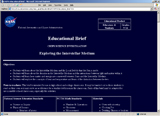Exploring The Interstellar Medium
Exploring The Interstellar Medium includes descriptions of Interstellar Medium and several hands-on activities. Within this unit, students will explore the science concepts of heat and temperature and the interactions between light and matter.
Key Questions
1. What is interstellar medium?
2. What is the local bubble?
3. Why are matter and energy conserved between stars and interstellar medium?
4. What is the connection between interstellar medium and stars?
Learning Objectives
1. Students will be able to use scientific experimentation to demonstrate why the sky is blue and to study the differences between heat and temperature.
2. Students will be able to calculate the volume of interstellar space in an average part of the galaxy.
3. Students will be able to name at least two ways the interstellar medium can be heated.
4. Students will be able to explain how interstellar medium is connected to the birth of stars.
General Subject Areas
Space Science
|
 Author: CSE @ SSL
Author: CSE @ SSL
VIEW THE LESSON
Student Activities
The lesson starts with a review of interstellar medium. Students are encouraged to read the information given on the web and take note of the main ideas. Students answer review questions and attempt several math problems with the teacher. Students will then explore, through a lab activity, why the sky is blue and explore the differences between heat and temperature.
Student Prerequisites
Math skills from Algebra and above.
Assessment
Review questions and problems on website. Answers to word problems are found on the student web page.
Extended Learning
N/A
|
Time Requirements
The web activity requires 45-60 minutes of students reading and recording main ideas. 30 minutes for class discussion.30 minutes for answering review question and math problems.Lab activity requires 1 hour of prep time and 45-60 minutes per student for hands-on activities.
Materials Required
-Online computer access with WWW browser capability
Required Plugins
N/A
Additional Resources
Lesson Plan
Best For Grades
high school
National Science Education Standards (NSES)
grades 9-12
State Science Standards
Grades 9-12 Earth Sciences
Have a science question? Visit our Ask an Expert page. Email questions or comments about SEGway resources to: outreach@ssl.berkeley.edu
|












